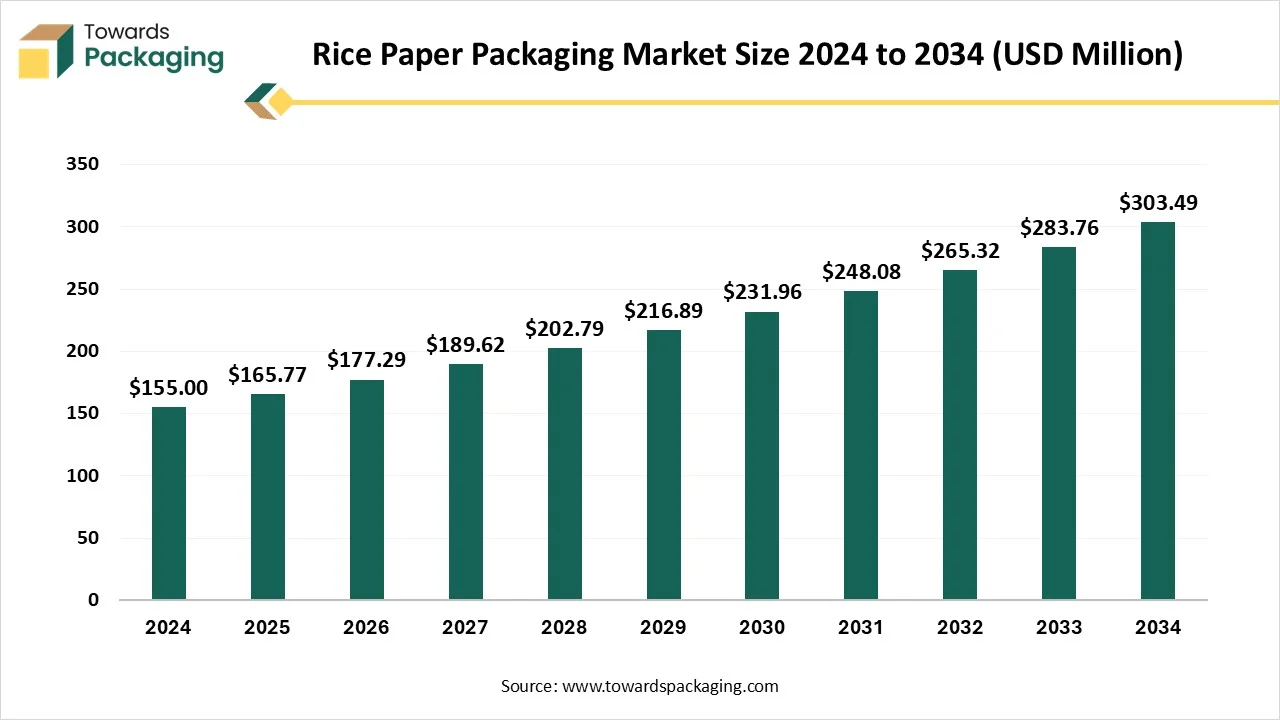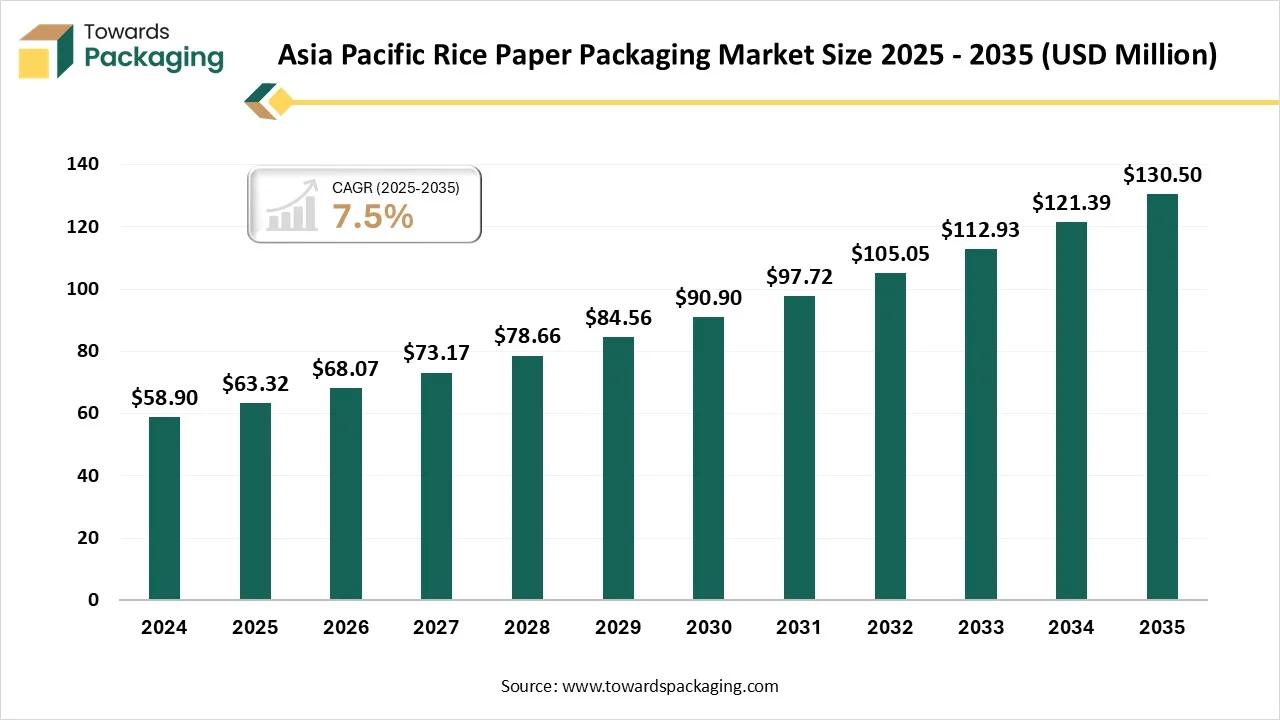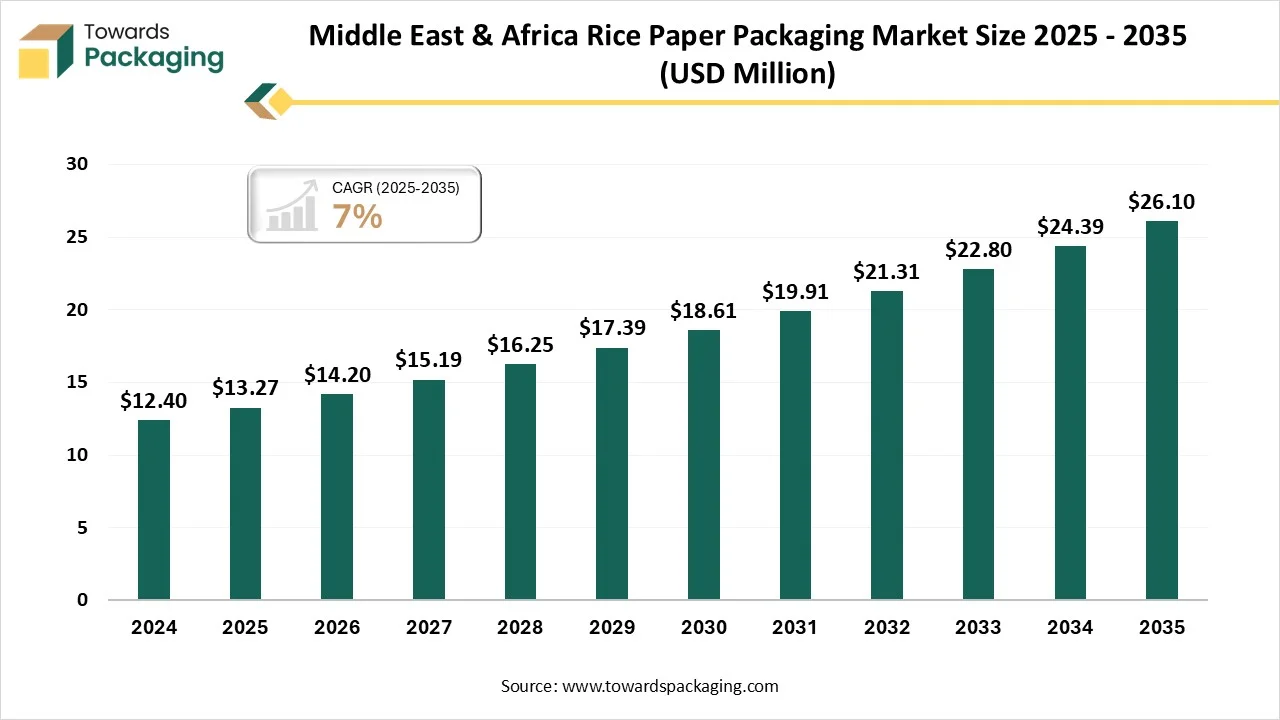December 2025
The rice paper packaging market is projected to grow from USD 177.29 million in 2026 to USD 324.58 million by 2035, reflecting a CAGR of 6.95% from 2026 to 2035. This market includes both edible and non-edible rice paper products used in food packaging, specialty items, and consumer convenience. The Asia Pacific region leads with a dominant share, while Europe is expected to experience significant growth. The market also sees rising demand for eco-friendly, biodegradable materials driven by regulatory pressures on single-use plastics.

The rice paper packaging market includes the production and commercialization of edible and non-edible rice paper films used for food wrapping, specialty packaging, and consumer convenience. Rice paper packaging is made from rice flour, tapioca starch, and water, forming thin, flexible sheets that are biodegradable, compostable, and sustainable. It is widely applied in ready-to-eat foods, confectionery, bakery, and frozen products.
Key stakeholders include food manufacturers, packaging converters, and retailers, with supply chains incorporating extrusion, drying, and lamination processes, along with coating technologies to improve moisture resistance and mechanical strength.
| Metric | Details |
| Key Growth Drivers | Rising consumer awareness of sustainable packaging, government restrictions on single-use plastics, demand for clean-label products, and preference for lightweight and transparent packaging |
| Leading Region | Asia Pacific |
| Market Segmentation | By Product Type, By Application, By End-Use Industry, By Form, By Distribution Channel and By Region |
| Top Key Players | Huakang Paper & Packaging, AEP Industries, Futamura Group, Paix Packaging, Oji Holdings Corporation, Anhui Yinghua Food Packaging, Shanghai Sun Paper Products |
Current users expect more from producers and packaging design than just protection or aesthetics. They find smooth packaging that matches their values -specifically around environmental convenience and responsibility. This has driven manufacturers and companies to invest in smart packaging that mixes digital features like sensors, QR codes, and NFC tags that develop the user experience through traceability, interactivity, and real-time information.
As per the global data, Rice paper packaging from May 2024 to April 2025, the exports done by 332 exporters to 661 buyers, marking a development rate of 39% as compared to the preceding twelve months.
During this period, in April 2025, I was single. 601 rice paper packaging has exported shipments that were created with 60% growth as compared to April 2024, and a 0% series growth from March 2025.
Majorly the rice paper packaging exports from the world go to Ukraine, Vietnam, and South Korea. Globally, the top three exporters of rice paper packaging are the European Union, Vietnam, and Ukraine.
| Material | Advantages | Disadvantages |
| Polypropylene (Woven) | Strong, lightweight, cost-effective, moisture and pest-resistant | Not biodegradable, limited printability, can degrade under sunlight |
| Jute/Cotton (Fabric) | Biodegradable, eco-friendly, reusable, naturally breathable | Poor moisture barrier, relatively heavy, may need liner |
| Laminated (BOPP) | Excellent barrier protection, attractive printed surface, durable | Higher cost, multi-layer structure makes recycling difficult |
| Paper/Cardboard with Inner Liner | Good for branding, recyclable if dry, lightweight | Weak barrier against humidity, liner-dependent durability |
| Multi-layer Plastic (PE/PET) | Superior sealing, moisture-proof, customizable with transparent windows | Not eco-friendly, vulnerable if seal breaks, harder to recycle |
The edible rice paper segment has dominated the rice paper packaging market with a 65% share in 2024, as edible rice paper packaging, which is made from biodegradable and frequently food-grade materials, serves as an exciting, eco-friendly alternative to regular plastics. Imagine a packaging that not only delivers its aim of protecting products but can also be used or composted without leaving toxic waste behind. From seaweed-based wrappers for snacks to rice-paper containers for beverages, edible rice paper packaging is developing as one of the most inventive and actual solutions to the worldwide plastic crisis.
The non-edible rice paper is expected to be the fastest in the market with 2% share during the forecast period. Non-edible rice paper, which is different from the edible version utilised for the spring rolls, has become famous in packaging due to rising environmental issues and growth in production technology. Producers developed the latest materials and procedures to make an aper with the reliability and protection needed for the packaging.
Eleven inventions have stretched non-edible rice paper, utilising rice paper beyond basic wraps and bags. The current manufacturing procedure develops its functionality, which makes it perfect for a variety of demanding uses.
The food packaging segment has dominated the market with a 55% share in 2024, as most regular packaging materials are non-recyclable. To align with consumer demand, producers have to make new compostable packages from the start, which leads to a decrease in greenhouse gases in the air.
Also, rice paper is created from a plant named the Tetrapanax papyrifer. This plant is technically processed along with other renewable materials like rice straw pulp and bamboo, too. These raw materials need fewer resources in order to track, and some can be regenerated to solve the rising demand.
The ready-to-eat meals packaging segment is predicted to be the fastest-growing segment in the market with a 25% share during the forecast period. Rice paper has become heavily famous in kitchens globally, serving as an evergreen and healthy alternative to regular wrappers. From sensitive Vietnamese spring rolls to inventive current making, rice paper serves as the accurate basis for both regular and contemporary dishes. The thin, translucent sheets created from water and rice flour serve a neutral flavor that praises any filling while serving an elegant presentation.
The food and beverages segment has dominated the market with a 60% share in 2024, as rice paper sheets should be accurately made before you start using spring rolls; otherwise, he spring rolls may not hold together and could fall apart. Dissolving the rice paper sheets in the warm water is necessary to make them pliable and soft, too. Dip the rice paper into the water for a few seconds until it becomes flexible but still constant enough to hold its shape.
The water utilised to soak the rice paper should be warm but not too hot. A perfect rule of thumb is to utilise water which is comfortably warm to the touch, similar to the temperature of bath water, to make sure the rice paper softens correctly.
The retail and e-commerce segment packaging is expected to be the fastest in the market with a 20% share during the forecast period. Rice paper is initially used in retail and e-commerce as a sustainable and aesthetically pleasing alternative to plastic packaging. It assists Barbados in reducing its environmental footprint while catering to eco-conscious users. Edible rice paper is utilised to package coffee, candies, snacks, and other minute food items that serve as a biodegradable and natural option. A durable and paintable material, rice paper is being sold for crafts and arts, including decoupage and mixed media art. The transparent, natural texture of the rice paper appeals to organizations that concentrate on zero-waste and wellness. It is used to cover items like bath bombs and soap bars.
The sheets and films segment has dominated the market with a 50% share in 2024 as rice paper sheets are brittle and sensitive, so their packaging must protect them from toxic and moisture too. Many of the retail packaging includes an inner plastic food inside a paperboard or strong plastic box, while professional and heavy packaging may use big films or bags.
This is the most prevalent form of inner packaging and makes a necessary moisture barrier for the sheets. The packaging should be handled with care as the brittle sheets can conveniently crack.
Laminated and coated films segment are predicted to be the fastest in the market with an 18% share during the forecast period. Laminated and coated films became famous in rice paper packaging as they mainly develop the material's protective properties. That stretches the shelf life of the food products and improves marketability. While regular rice appears to be biodegradable and aesthetically appealing, it lacks enough barrier protection against oxygen, moisture, and other pollutants. Current films solve these shortcomings, which shift rice paper into a highly regular and durable packaging solution.
The direct sales segment has dominated the rice paper packaging market with a 58% share in 2024, as rice paper packaging can be bought directly from producers, online distributors, and wholesalers. The urge for their biodegradable packaging is rapidly developing as a sustainable alternative to plastic, particularly in the food and beverage and retail industries. Buying directly from the producers is perfect for big-volume orders and tailored solutions. We demand that packaging organisations meet to discuss elements and smaller order quantities.
The e-commerce and online retail segment is predicted to be the fastest-growing in the market with a 22% share during the forecast period. E-commerce sales of rice paper packaging are witnessing fast development, which is being driven by the developing consumer demand for sustainable alternatives to plastic, stricter environmental regulations, and innovations in product customization. Besides food, e-commerce brands are utilising sustainable packaging and retail packaging. The materials' natural tone serves a high-end feeling that appeals to a luxury market.
The biggest application for the rice paper packaging is in the food and beverage sector, which accounted for over 53% of the industry share in the year 2024.

Asia Pacific dominated the rice paper packaging market share of 45% in 2024, as this region is a center for rich and varied culinary traditions, which continue to dominate the edible rice paper industry. As the birthplace of the product, countries such as Vietnam, China, and Thailand have long been the initial suppliers and manufacturers of rice. Hence, the industry is now stretching beyond its regular core, with growing markets such as Indonesia, India, and Malaysia experiencing growing usage due to movement in dietary habits and the developing popularity of Asian Cuisine.
Top India Insights For Rice Paper Packaging Market
The urge for rice paper packaging in India is witnessing strong development, which is being driven by the growing user choice for eco-friendly packaging and supportive government regulations. A main and rising segment of Indian users is becoming more aware of the environmental issues and actively finding sustainable products.
The food and beverage industry is the biggest user segment for rice paper packaging. The growth of online food delivery and e-commerce is driving the demand for cutting-edge, smooth, and lightweight packaging solutions.
The Europe is predicted to be the fastest-growing market with 28% share during the forecast period. European countries, specifically in western countries like the UK and Germany, are increasingly willing to pay more for eco-friendly products. The food service and delivery industries are quickly accepting rice paper packaging as a sustainable alternative to plastic containers for snacks, wraps, and takeaway items. The developing popularity of European and health-conscious cuisines also fulfills the urge for specialist food covers. The urge for natural rice paper packaging in Europe is growing and developing, which is directly driven by the regulations for single-use plastics and the powerful industry's huge development towards sustainable and eco-friendly alternatives.
Top Germany Insights for the Rice Paper Packaging Market
The Germany region rice paper industry is witnessing a notable move towards plant-based diets and health-conscious consumers with developing urges across foodservice, retail, and other channels. The gluten-free and vegan segments are growing rapidly, driven by user awareness of dietary restrictions and sustainable consumption habits.
Innovations in biodegradable and extrusion technology packaging materials are setting the latest standards for product classification. Northern Germany develops greater market entry, which is being driven by the acceptance and health, in which rural regions show slow development, which presents tailored expansion opportunities.

The demand for rice paper coffee packaging has been developing for years, and the industry for it continues to rise, in line with the industry’s demand for more sustainable packaging alternatives. Though paper bags for coffee are by no means the latest, rice and kraft paper with PLA have become considerably more popular among roasters in recent years.
Oryzite, which is a Spanish invention company, has launched a sustainable packaging material that comes from rice husks, delivering an alternative to regular fossil-based plastics. Through a universally patented procedure, Oryzite updates rice husks, which are an agricultural by-product, into an evergreen thermoplastic material called Oryval.
By Product Type
By Application
By End-Use Industry
By Form
By Distribution Channel
By Region
December 2025
December 2025
December 2025
December 2025